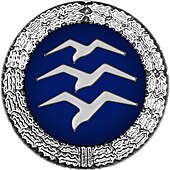International Gliding Commission
The International Gliding Commission (ger .: International Gliding Commission shortly IGC) is the international regulatory and certification body for the glider . The IGC is one of several commissions of the Fédération Aéronautique Internationale (FAI), the global umbrella organization for air sports .
history
The IGC, founded in 1932 under the name Commission Internationale de Vol à Voile (CIVV) , was at times referred to as the Commission de Vol Sans Moteur (CVSM) , i.e. commission for flights without a motor . Since its inception, it has been the FAI's responsible commission for monitoring and recognizing records, competitions and badges in gliding and motor gliding .
Paraglider and hang-glider pilots have the CIVL, their own commission, the Commission Internationale de Vol Libre (CIVL), although they are also non-motorized .
Aerobatics with gliders is another special form . He is subordinate to the Aerobatic Commission Internationale de Voltige Aérienne (CIVA) , which oversees all types of aerobatics.
Achievement badge
On June 13, 1930, the International Study Commission for Motorless Flight (ISTUS) was founded in Frankfurt to recognize international achievements in the field of gliding. Founding members were Belgium , Germany , France , the Netherlands , Italy , Hungary and the USA . From 1930 until the beginning of the war, the German meteorologist and pioneer of glider research Walter Georgii was President of ISTUS. In recognition of this, a number of badges were created for different levels of ability, called A, B, and C badges. Three stylized seagulls are depicted in the round badge. It was designed by Fritz Kramer. With the founding of the International Gliding Commission by the FAI, the IGC took over the tasks of the ISTUS. Today, the tasks of recognition - on behalf of the FAI - are performed by the national air sports associations. In Germany this is the German Aero Club .
The names have changed over time. The A-exam (up to C-exam) still passes today.
silver
For the silver badge of achievement " Silver " (this is usually the first badge of achievement after the pilot's license) an altitude gain of 1,000 m, a flight of five hours and a target flight of at least 50 km is required. It is permissible to provide these services on different flights. The first people to receive this award were Wolf Hirth and Robert Kronfeld on February 15, 1931.
gold
The gold badge follows the silver badge. The conditions are an altitude gain of 3,000 m, a flight of five hours and a flight of at least 300 km. Here, too, it is permissible to provide these services on different flights.
Diamonds
Three diamonds can be acquired for the silver or gold badge. The conditions are per diamond:
- An altitude gain of 5,000 m
- A flight over 300 km as a return route or triangular route
- A flight of 500 km.
Diplomas and records
Due to the progressive development in gliding, it became necessary after 1960 to expand the performance levels with regard to the flight routes achieved. Today there is a diploma, which is awarded from 750 km flight distance - in steps of 250 km.
The longest flight distance ever achieved with a glider is 3,008.8 km. It was flown by Klaus Ohlmann in the Andes . In Europe, on April 25, 1972, Hans-Werner Grosse managed a flight of 1,460.8 km from Lübeck to Biarritz . On January 12, 2011, Klaus Ohlmann flew 1,875.2 km on a triangular flight in the Andes. He set a new speed record with 119.29 km / h.
Logger
With the help of a logger , all relevant flight data are recorded that are required for the evaluation of competitive flights and world record attempts. Due to the drop in the price of electronic navigation systems , the IGC developed a specification that all recognized loggers must comply with. This meant that all documentation methods that had existed to date, such as photo evidence, became obsolete. IGC-compliant loggers are now the only approved documentation system.
OSTIV
Another subdivision is the Organization Scientifique et Technique du Vol à Voile (OSTIV), which is supposed to establish contacts between the manufacturers of gliders and the pilots for the exchange of opinions and experiences.
Web links
- IGC website , English
Individual evidence
- ↑ Fédération Aéronautique Internationale - FAI
- ↑ FAI Hang Gliding and Paragliding Commission - CIVL ( Memento of the original from November 20, 2006 in the Internet Archive ) Info: The archive link was automatically inserted and not yet checked. Please check the original and archive link according to the instructions and then remove this notice.
- ↑ FAI Aerobatics Commission - CIVA ( Memento of the original from December 7, 2006 in the Internet Archive ) Info: The archive link was automatically inserted and not yet checked. Please check the original and archive link according to the instructions and then remove this notice.
- ↑ Application form for download
- ↑ a b c International Achievement Badge for Glider Flying. In: www.daec.de. German Aero Club, accessed April 10, 2020 .
- ↑ Record flight
- ↑ On-Line Contest (OLC) 2011 worldwide
- ↑ German gliding records 2010–2012
- ↑ Pilot record (world speed record 119.29 km / h) by Klaus Ohlmann ( Memento of the original from December 15, 2015 in the Internet Archive ) Info: The archive link was automatically inserted and not yet checked. Please check the original and archive link according to the instructions and then remove this notice. (PDF; 5 kB)
- ↑ FAI - Technical specification of recorders ( Memento of January 7, 2010 in the Internet Archive ), PDF


